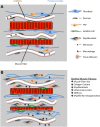Cellular mechanisms of tissue fibrosis. 4. Structural and functional consequences of skeletal muscle fibrosis
- PMID: 23761627
- PMCID: PMC3742845
- DOI: 10.1152/ajpcell.00173.2013
Cellular mechanisms of tissue fibrosis. 4. Structural and functional consequences of skeletal muscle fibrosis
Abstract
Skeletal muscle fibrosis can be a devastating clinical problem that arises from many causes, including primary skeletal muscle tissue diseases, as seen in the muscular dystrophies, or it can be secondary to events that include trauma to muscle or brain injury. The cellular source of activated fibroblasts (myofibroblasts) may include resident fibroblasts, adult muscle stem cells, or inflammatory or perivascular cells, depending on the model studied. Even though it is likely that there is no single source for all myofibroblasts, a common mechanism for the production of fibrosis is via the transforming growth factor-β/phosphorylated Smad3 pathway. This pathway and its downstream targets thus provide loci for antifibrotic therapies, as do methods for blocking the transdifferentiation of progenitors into activated fibroblasts. A structural model for the extracellular collagen network of skeletal muscle is needed so that measurements of collagen content, morphology, and gene expression can be related to mechanical properties. Approaches used to study fibrosis in tissues, such as lung, kidney, and liver, need to be applied to studies of skeletal muscle to identify ways to prevent or even cure the devastating maladies of skeletal muscle.
Keywords: muscle mechanics; myofibroblast; passive mechanics; stiffness.
Figures









References
-
- Abrams RA, Tsai AM, Watson B, Jamali A, Lieber RL. Skeletal muscle recovery after tenotomy and 7-day delayed muscle length restoration. Muscle Nerve 23: 707–714, 2000 - PubMed
-
- Ahsan T, Sah RL. Biomechanics of integrative cartilage repair. Osteoarthritis Cartilage 7: 29–40, 1999 - PubMed
-
- Bahi L, Koulmann N, Sanchez H, Momken I, Veksler V, Bigard AX, Ventura-Clapier R. Does ACE inhibition enhance endurance performance and muscle energy metabolism in rats? J Appl Physiol 96: 59–64, 2004 - PubMed
-
- Barton ER, Gimbel JA, Williams GR, Soslowsky LJ. Rat supraspinatus muscle atrophy after tendon detachment. J Orthop Res 23: 259–265, 2005 - PubMed
Publication types
MeSH terms
Substances
Grants and funding
LinkOut - more resources
Full Text Sources
Other Literature Sources
Medical
Miscellaneous

